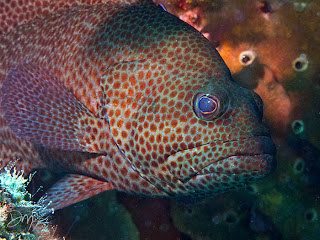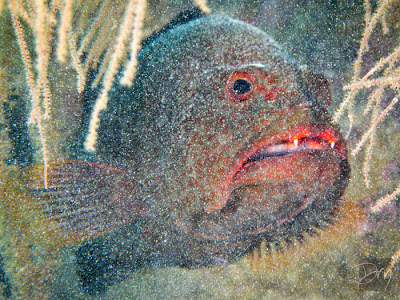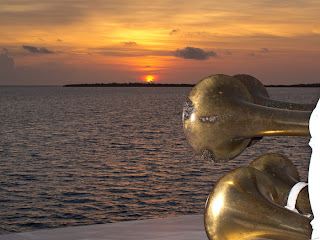Click an image for a larger view and scroll through images as you like. Then click outside the image to return to the story. Enjoy!
 |
| Christmas Tree Worms on Brain Coral |
 |
| Green Turtle |
A year ago, my brother Jay invited me to join him for a May 2012 scuba diving trip to Belize. I am a certified diver, but hadn't done any serious diving in many years, always preferring snorkeling for its simplicity. But it was a chance to travel with one of my brothers, something I do far too little, so I said "Great!". With plenty of lead time, I began investigating options for an underwater camera rig.
 |
| Diving a wall |
 |
| Green Moray with Neon Goby cleaner fish |
 |
| Bermuda Chubs and brother Jay |
My experience to date was using my wife's small waterproof Pentax point-and-shoot a few times. I wanted something more serious than that -- a camera that would shoot high rez photos in RAW format, a separate strobe for bringing out the true colors, a rig that is not too bulky or heavy, and all together, one that fit my budget. Ha! That's a tall order.
Naturally, I spent a bit more than I wanted, but got a nice camera (Canon G12), a waterproof housing, and pair of strobes (Ikelite AF35) that all fit in a pretty compact travel-friendly bundle. My trial runs were scant and not very successful (in our icy cold sink hole), but at least I learned how to run the camera from the buttons on the housing and how to fire the strobes.
 |
| Tube Sponges and Soft Corals |
 |
| Scorpionfish |
 |
| Striped Grunt on Brain Coral |
We flew out of Miami with a friendly bunch of scuba enthusiasts assembled by Alan, our group leader from Jay's dive shop, American Divers International. In Belize, we lived aboard a beautfully-designed dive boat, the Sun Dancer II. I'd never been on a "live-aboard" before, so I have no comparison, but I can't imagine a nicer or more capable crew, a more comfortable boat, better food, or a more efficient way to dive. She held 20 divers plus the crew. Voyaging out to the reefs of Lighthouse Atoll the first night, we never left the open water for the rest of the week. Spectacular reefs, walls, caves, and sea life sprawled for miles beneath our hull for 5 days of diving up to 5 dives per day -- two morning dives, two afternoon dives, and one night dive. That is intense scuba diving!

My learning curve in underwater photography was equally intense. Unfortunately I didn't bring a device on which I could download my RAW files and the boat's common room computer could not recognize the format, so I could only view my images on the camera's LCD screen - not much to go by, but enough I guess. I also learned from other photographers on the trip by viewing their images and heeding their advice. I spent quite a few dives following Keith K. around, watching his techniques, and then seeing what he came up with. In the end, I returned home with 3 memory cards filled with hundreds of photos and with hope that I got some good shots. Here I am trying to get a photo of a Spotted Moray Eel.
 |
Photo by Keith Kaplan
|
The diversity of reef fish is mind-boggling. So many shapes, colors, and behaviors. Like that scorpionfish above - a master of disguise! Here are a few more.
 |
| Pair of Gray Angelfish |
 |
| Hogfish |
 |
| Queen Triggerfish |
 |
| Strawberry Grouper |
 |
| Queen Angelfish |
Wanting more than "documentary photos" of fishes or corals, I searched for clean compositons as much as cool creatures. My years of photographing nature, wildlife, landscapes, and macros in all sorts of situations really helped too.I missed many shots of passing turtles, sharks, or rays because my settings needed changing and the moment passed too quickly. Likewise I messed up many shots by using wrong settings especially with my strobes. But by the end I was getting the swing of it and did all right.
 |
| Royal Grammas (Fairy Basslets) on Star Coral |
 |
| Soft Coral and Tube Sponges |
 |
| Tube Sponges and Brain Coral |
Jay was easygoing and patient... and had a small camera of his own. We usually followed the divemaster for awhile until we got distracted or fell behind. We only got sort-of-lost once or twice.
 |
| Jay |
 |
| Scrawled Filefish |
 |
| Tube Sponges and Coral Reef |
The night dives were especially challenging - being at the end of a long day, having a mediocre divelight, being a little creeped out, and finding my camera and strobes required very different settings. Still, we managed to see some of the strange night critters, like octopi, squid, crabs, coral polyps in "full bloom", sea snails, and basket starfish.
 |
| Nightscape |
 |
| Octopus peeking out |
This beautiful squid hovered a foot in front of me for a long time. I couldn't get my strobe right (first night) so I just watched it as colors rippled and changed. Here's a photo Keith got.
 |
| Squid. Photo by Keith Kaplan |
Getting in close for macro shots was great fun. As long as I didn't blowout the image with too much light, the color in macros was especially vivid because there was less "blue filter" (water). I found it tough to hold still enough to compose and focus on detail since I was free-floating!
 |
| Giant Hermit Crab |
 |
| Macro at night. Coral Polyps and Tube Sponge |
 |
| Loggerhead Sponge close up |
 |
| Christmas Tree Worms on Finger Coral |
We made one deep dive to 130 feet in the famous Blue Hole. There we saw bizarre giant stalactites, remnants of an ancient dry cave system. Here's an image of me and a smaller stalactite made by Keith Kaplan. I decided not to risk my rig at those pressures since it was pushing my housing's depth limits.
 |
| Yours Truly. Photo by Keith Kaplan |
My favorite photo of the week was made by Deanna Lorinser as an enormous loggerhead sea turtle approached her. Our divemaster, Simon, was swimming beside the turtle. Here is Deanna's photo.
 |
| Loggerhead Turtle and Simon. Photo by Deanna Lorinser |
The reefs of Belize are still fairly pristine compared to many tropical coral reefs around the world. Climate change, silt and pollutants from coastal runoff, and oil spills have all contributed to their demise. The one threat we witnessed first hand in Belize was the exotic Lionfish. Native to the Pacific, this fish has been introduced to the Atlantic through careless aquarists releasing them as well as escapees from storm events. A critical number was reached and now they are reproducing like crazy along the entire Eastern US seaboard and throughout the Caribbean. Lionfish are voracious eaters of small reef fish and have deadly toxic spines in their dorsal and pectoral fins so no larger predators can eat them. We saw them on every dive on every reef. At one reef in the Turneffe Atoll, lionfish were everywhere, with noticeably fewer other species of reef fish. Despite this growing threat, I have to admit lionfish are beautiful. Here's one of many lionfish images that I liked for the symmetry and white-finned display. (They pose fearlessly.)
 |
| Lionfish, pointing dorsal spines toward me |
After 5 days and many dives, camera memory cards bulging full, skin wrinkled, ears water-logged, heart sated by coral reef beauty, I was ready to return to our woodland paradise in Wakulla County, FL. For me, it was a once-in-a-lifetime trip, one that freshened my awareness of this entire other-worldly realm - a realm that is both vast and fragile, one full of mystery and awe, and one that we must respect and take care not to destroy.
 |
| Ruby Lips. Strawberry Grouper in silted water. |

































8 comments:
Simply breathtaking, and your narrative adds so much. Thank you for sharing your incredible experience, it is such a gift to be able to see exquisitely beautiful parts of our world that I would not otherwise see!
That Strawberry Grouper needs a counseling session with the Loggerhead Turtle.
That's quite a photo journal.
Thanks! Glad you enjoyed it.
Incredible work David!!! Having done some underwater photography back in the day of the Nikonos IV, I can appreciate the many additional challenges it poses, but you brought back professional quality shots on your first trip!!
Amazing pictures, especially for your first serious attempts underwater. Love the one of the Royal Grammas expecially. Becca
Beautiful photos! Great story too!
The colors jump right off the screen. Great shots, every one of them. Unlike Sasquatch, I think the strawberry grouper is at home in his scales.
wisk I had a pice of that yellow maze brain in my reef tank.awesome photos!
Post a Comment